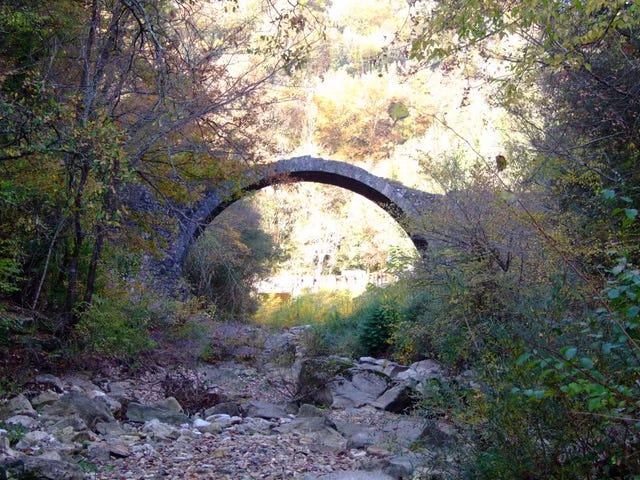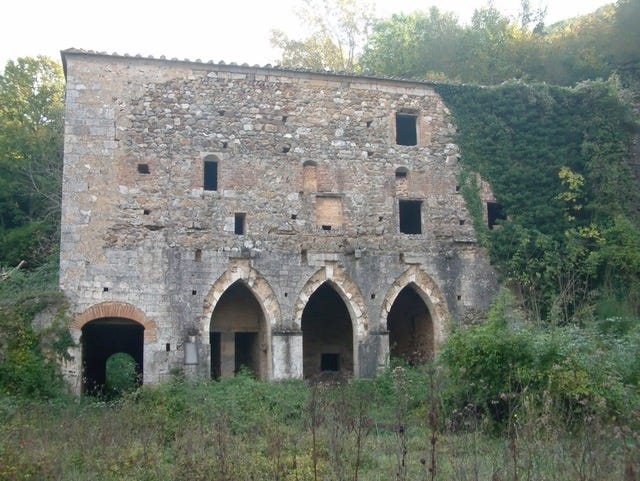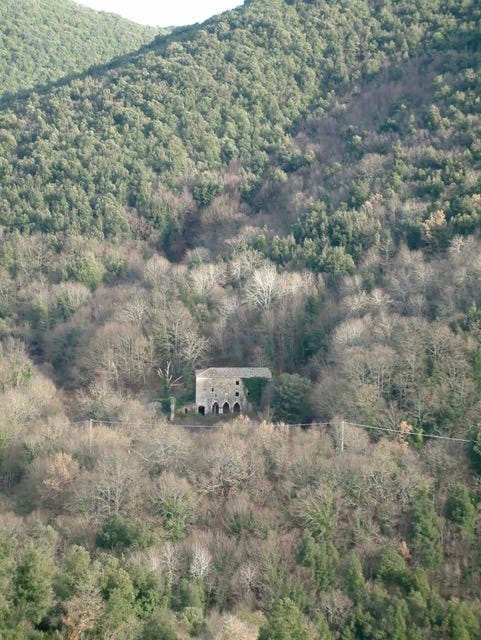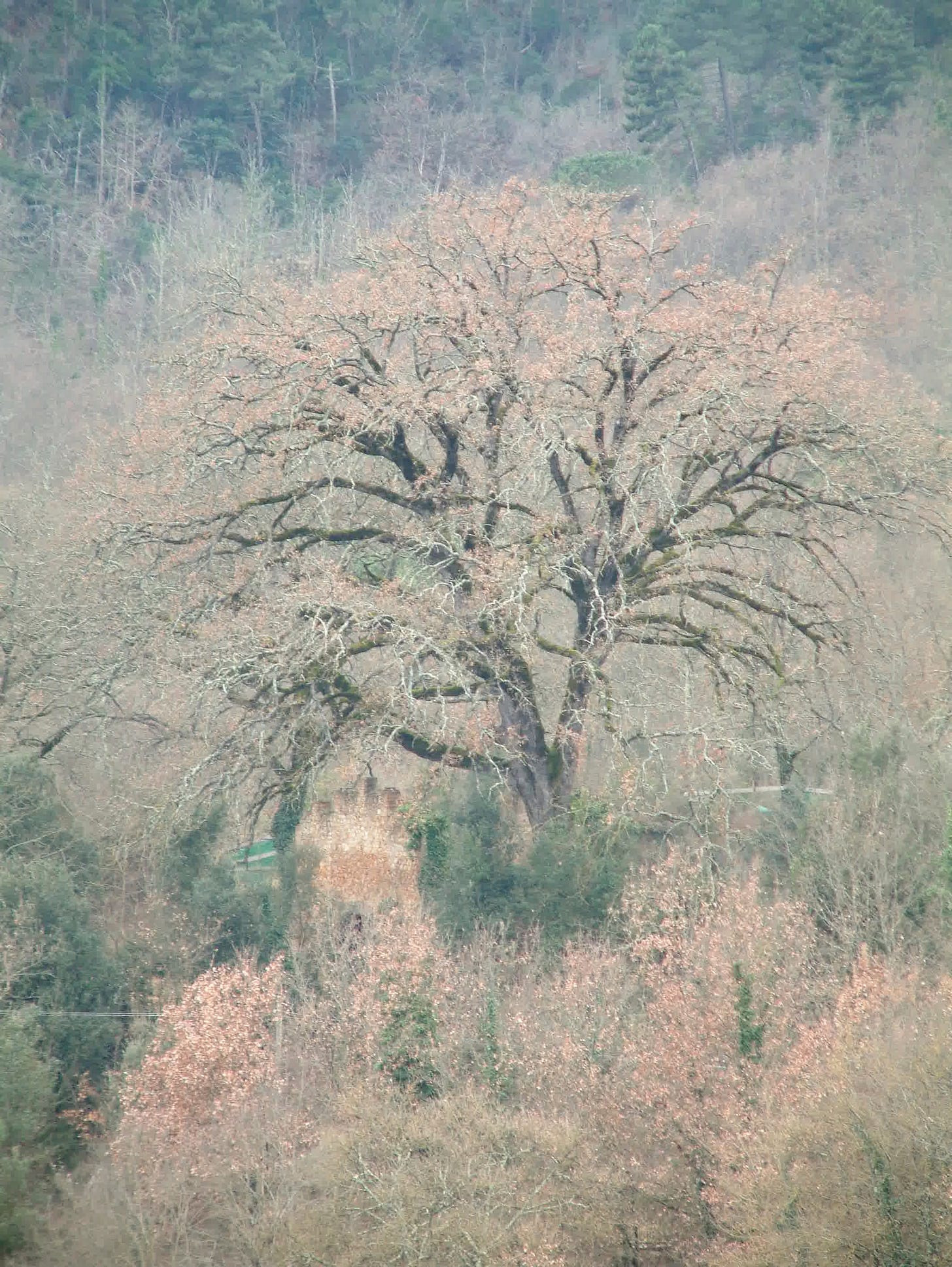The Hermitage of Santa Lucia
a walk in the Tuscan woods; a lesson from the forest-dwellers for the end times
Secluded within a dense forest of ilex, oak, and beech trees, high on a ridge near Rosia (SI), lie the ruins of a medieval hermitage dedicated to Saint Lucy. To reach this place, you park near the medieval Ponte della Pia gracefully arching over the Rosia torrent, and follow a winding trail into the woods. Red arrows painted on stones and tree trunks guide the way.
I visit the hermitage this cold winter morning, mindful of its dedication to St. Lucy, patron saint of the blind. Her feast day, December 13th, is traditionally believed to be the shortest day of the year. Tonight, in many homes, candles will be lit before her icon, depicting a young woman holding a plate bearing her two plucked-out eyes. Rather than martyrdom, those eyes symbolize the light of the heart which can illuminate the darkest of our days. She opens the way to the return of the light.
Icicles hang from the bridge and sparkle along the frozen stream. As I make my way up the trail, I glimpse the remains of the ancient road that once brought pilgrims here. Like the nearby Abbey of Torri, the Hermitage of Santa Lucia lay along a detour from the Via Francigena, a pilgrim route to Rome, and once served as a sanctuary for weary travelers.
It is a twenty-minute walk up through the thick of the forest along a trail lined with wild asparagus and butcher’s broom, decked out for the holidays with bright red berries. Finally, I come out into a clearing – and there before me rise the moldering ruins of Santa Lucia, like a decayed jewel box, or a half-eaten, petrified wedding cake.
The convent, a two-story structure of gray stone with Gothic arches reflecting Cistercian simplicity, is the only intact building. Its doors and windows are sealed to deter curiosity-seekers: the place looks as if it might come tumbling down with the slightest push. Nearby are the remnants of a church—a small enclosure and a crumbling apse. Thick veins of brambles and ivy keep the weathered walls from total collapse.
Santa Lucia’s origins have been traced back to a group of hermits dwelling in these woods, dedicating themselves to prayer and austerity. As the Roman Empire disintegrated and urban chaos spread, many sought solace and safety in remote natural sanctuaries. By the third century, Italy’s landscapes were dotted with hermit communities, drawn to cliffs, waterfalls, secluded woods, and far flung islands where they practiced spiritual contemplation. These solitaries sometimes banded loosely together, gathering for meals and worship without formal hierarchy.
The original community at Santa Lucia is believed to have been founded by Augustinian anchorites from Africa in the fourth century. Following the Rule of St. Augustine, they practiced charity, poverty, silence, fasting, and detachment. Upon reaching Tuscany, the anchorites founded five communities, including Santa Lucia near Rosia and Lecceto closer to Siena. According to tradition, St. Augustine himself once visited these pious forest dwellers. Later, Lecceto became home to English scholar William Flete, spiritual mentor to St. Catherine of Siena.
For over five centuries, Tuscan hermits inhabited these woods in caves and simple shelters. Sometimes men and women lived together, chastely, it is presumed, although not necessarily. These communities were self-regulating, guided by no rules or hierarchy except the dictates of individual conscience. Despite their longing for seclusion, some hermits found themselves much more popular than they desired, attracting disciples, unwanted admirers, or hangers-on looking for a safe place.
By the mid-tenth century, the Church had become wary of these loose communities and pressured them to organize and regulate themselves, build permanent structures and embrace monastic rule. Many communities complied; others fragmented and their members scattered. Up until not so long ago, there were still hermits in the mountains of Central Italy and on the islands of Lazio.
The first structures of Santa Lucia were built over the site where the bones of the early hermits had been laid to rest. The hermitage was rebuilt in the thirteenth century, after a fire destroyed the previous buildings. One wonders how they lived before those buildings were erected. What did they eat? How did they spend their days? In summer, they’d have been surrounded by hoopoes and nightingales and would have nourished themselves on wild birds, figs, berries, and many edible wild plants; in autumn mushrooms, chestnuts – an occasional pheasant. In winter how did they keep warm in those caves when it snowed?
Within a half hour’s walk stood the towers of the wealthy, with small villages clustered at their base. Not far off lay the headquarters of Siena’s wool working guild. Surely pious villagers crossed the Ponte della Pia bridge to bring food or other gifts to the hermits. Once the hermits had submitted to monastic rule, some of their freedom was surely lost, but their comfort and diet probably improved. Under monastic rule, life went on in the woods with its simplicity and faith, far from the temptations, noise, and corruption of modern urban life as it was then.
And then catastrophe struck, shattering the peace and solitude of this community. A catastrophe we moderns can only dimly imagine – although we had a tiny glimpse back in 2020. Between 1347 and 1351, the Black Death killed 25 million people worldwide, shrinking the populations of European cities by 50 to 60%. In Siena alone, 80,000 perished. In the midst of this apocalypse, the Augustinian fathers were called from Santa Lucia to Siena to help nurse the sick. The hermitage itself may have served as an infirmary during this period.
The plague’s horrors were unparalleled. Victims died within hours of the first symptoms, enduring tumescent swellings and hemorrhaging fevers. Families broke apart as survivors abandoned their dying loved ones to avoid contagion. Even animals became infected: dogs, cats, birds, chickens died. Cities were overwhelmed with decomposing corpses, and societal collapse ensued. City administration, food production and commerce ground to a halt. Public order could not be kept. Scavenging and thievery from the homes of the wealthy dead was the rule of the day. There was a surplus of goods of every kind at first: food, clothing, luxuries. Common women went about in the clothes and jewels stolen from the homes of the aristocratic ladies who had died. Morals relaxed, people lived as they pleased.
While some indulged in hedonism, others turned to extreme penitence, forming flagellant groups who marched and whipped themselves in public acts of atonement. Doctors fled the cities, while charlatans hawked false remedies.
Amid this turmoil, the brothers and sisters of all religious orders risked their lives to care for the sick. Many died, and the community of Santa Lucia never fully recovered, although a few stragglers continued to inhabit the place. Its buildings soon fell into disrepair, with some repurposed as granaries or barns. By the eighteenth century, Napoleonic reforms led to the hermitage’s closure, and it was converted into a farmhouse before being abandoned.
Though some buildings of the convent were still intact in the nineteenth century, its ruins now stand today as a poignant reminder of a once-thriving spiritual haven. The hermits never returned, and their voices of prayer have faded, leaving only the silent embrace of the forest to guard their legacy.
The hermits first sought shelter here when their society was coming apart. For almost a millennium, they flourished until a new crisis called them away – sacrificing not only their forest solitude but their very lives for others in the name of Christ. As we head into 2025, it feels as if the world is unraveling and that a tide of ignorance, fear, superstition and greed is about to wash over us again. Preppers eagerly await the opportunity to prove that the end times have arrived and seem to believe they can construct a DIY haven, safe from climate disasters, wars, deadly contagion. The hermits of Santa Lucia have a lesson to teach us. Their sacrifice reminds us that true sanctuary is not built from walls or provisions, but from a willingness to serve others, even at great personal cost—a lesson as urgent today as it was in their time.








Thank you for this little dedication,
you’ve inspired me to go and find this little spot and read this article again when I’m there.
Amazing post! Thank you. I really enjoyed it. :) Ladies wearing jewels from women who died from the plague...I'm tucking this away. It is this kind of detail that makes historical fiction great.